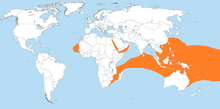
Back Alfred manta Afrikaans Manta alfredi Bulgarian Mobula alfredi CEB Riffmanta German Mobula alfredi Spanish Manta alfredi Basque Raie manta de récif French מנטת השונית HE Mobula alfredi Hungarian Manta alfredi Italian
| Reef manta ray | |
|---|---|

| |
| M. alfredi in the Maldives | |
| Scientific classification | |
| Domain: | Eukaryota |
| Kingdom: | Animalia |
| Phylum: | Chordata |
| Class: | Chondrichthyes |
| Subclass: | Elasmobranchii |
| Superorder: | Batoidea |
| Order: | Myliobatiformes |
| Family: | Mobulidae |
| Genus: | Mobula |
| Species: | M. alfredi
|
| Binomial name | |
| Mobula alfredi (Krefft, 1868)
| |

| |
| Synonyms | |
|
Manta alfredi | |
The reef manta ray (Mobula alfredi)[3] is a species of ray in the family Mobulidae, one of the largest rays in the world. Among generally recognized species, it is the second-largest species of ray, only surpassed by the giant oceanic manta ray.[4]
The species was described in 1868 by Gerard Krefft, the director of the Australian Museum. He named it M. alfredi in honor of Alfred, Duke of Edinburgh, the first member of the British royal family to visit Australia.[5] It was originally described as part of the genus Manta but in 2017 was changed, along with the rest of the mantas, to be included as part of the genus Mobula.[6]
Reef manta rays are typically 3 to 3.5 m (9.8 to 11.5 ft) in disc width,[7] with a maximum size of about 5.5 m (18 ft).[4] For a long time included in M. birostris, the status of the reef manta ray as a separate species was only confirmed in 2009.[4] The reef manta ray is found widely in the tropical and subtropical Indo-Pacific, but with a few records from the tropical East Atlantic and none from the West Atlantic or East Pacific.[4][8] Compared to the giant oceanic manta ray, the reef manta ray tends to be found in shallower, more coastal habitats,[4][8] but local migrations are sometimes reported.[9] Mobula birostris is similar in appearance to Mobula alfredi and the two species may be confused as their distribution overlaps. However, there are distinguishing features.
- ^ Marshall, A.; Barreto, R.; Carlson, J.; Fernando, D.; Fordham, S.; Francis, M.P.; Herman, K.; Jabado, R.W.; Liu, K.M.; Pacoureau, N.; Rigby, C.L.; Romanov, E.; Sherley, R.B. (2019). "Mobula alfredi". IUCN Red List of Threatened Species. 2019: e.T195459A68632178. doi:10.2305/IUCN.UK.2019-3.RLTS.T195459A68632178.en. Retrieved 20 November 2021.
- ^ "Appendices | CITES". cites.org. Retrieved 2022-01-14.
- ^ "Mobula alfredi". FishBase. Retrieved 2019-04-22.
- ^ a b c d e Marshall, Andrea; Compagno, Leonard; Bennet, Michael. "Redescription of the genus Manta with resurrection of Manta alfredi (Krefft, 1868) (Chondrichthyes; Myliobatoidei; Mobulidae)". Zootaxa (2301). Magnolia Press: 1–28. Retrieved 4 May 2014.
- ^ "Alfred Manta, Manta alfredi (Krefft, 1868)". Australian Museum. Retrieved 2016-05-15.
- ^ White, William T; Corrigan, Shannon; Yang, Lei; Henderson, Aaron C; Bazinet, Adam L; Swofford, David L; Naylor, Gavin J P (2017), "Phylogeny of the manta and devilrays (Chondrichthyes: mobulidae), with an updated taxonomic arrangement for the family", Zoological Journal of the Linnean Society (Journal article), 182 (1) (published 24 June 2017): 50–75, doi:10.1093/zoolinnean/zlx018
- ^ Cite error: The named reference
MantaTrustwas invoked but never defined (see the help page). - ^ a b "Manta Ray Research". Foundation for the Protection of Marine Megafauna. Retrieved 31 May 2012.
- ^ Germanov E, Marshall A (October 22, 2014). "Running the Gauntlet: Regional Movement Patterns of Manta alfredi through a Complex of Parks and Fisheries". PLOS ONE. 9 (10). PLOS: e110071. Bibcode:2014PLoSO...9k0071G. doi:10.1371/journal.pone.0110071. PMC 4206290. PMID 25337865.
© MMXXIII Rich X Search. We shall prevail. All rights reserved. Rich X Search
